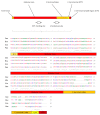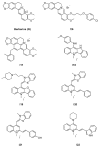Targeting Bacterial Cell Division: A Binding Site-Centered Approach to the Most Promising Inhibitors of the Essential Protein FtsZ
- PMID: 32046082
- PMCID: PMC7167804
- DOI: 10.3390/antibiotics9020069
Targeting Bacterial Cell Division: A Binding Site-Centered Approach to the Most Promising Inhibitors of the Essential Protein FtsZ
Abstract
Binary fission is the most common mode of bacterial cell division and is mediated by a multiprotein complex denominated the divisome. The constriction of the Z-ring splits the mother bacterial cell into two daughter cells of the same size. The Z-ring is formed by the polymerization of FtsZ, a bacterial protein homologue of eukaryotic tubulin, and it represents the first step of bacterial cytokinesis. The high grade of conservation of FtsZ in most prokaryotic organisms and its relevance in orchestrating the whole division system make this protein a fascinating target in antibiotic research. Indeed, FtsZ inhibition results in the complete blockage of the division system and, consequently, in a bacteriostatic or a bactericidal effect. Since many papers and reviews already discussed the physiology of FtsZ and its auxiliary proteins, as well as the molecular mechanisms in which they are involved, here, we focus on the discussion of the most compelling FtsZ inhibitors, classified by their main protein binding sites and following a medicinal chemistry approach.
Keywords: FtsZ inhibitors; GTP-binding site; bacterial cell division process; interdomain site.
Conflict of interest statement
The authors declare no conflict of interest
Figures










References
-
- Vishnyakov I.E., Borchsenius S.N. FtsZ and bacterial cell division. Cell Tiss. Biol. 2007;1:206–214. doi: 10.1134/S1990519X07030029. - DOI
Publication types
LinkOut - more resources
Full Text Sources
Molecular Biology Databases

